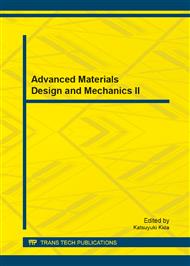[1]
I. Nettleship, R. Stevens, Tetragonal zirconia polycrystal (TZP)—A review, International Journal of High Technology Ceramics, 3(1) (1987)1-32.
DOI: 10.1016/0267-3762(87)90060-9
Google Scholar
[2]
X. J. Jin, Martensitic transformation in zirconia containing ceramics and its applications, Current Opinion in Solid State and Materials Science, 9(6) (2005) 313-318.
DOI: 10.1016/j.cossms.2006.02.012
Google Scholar
[3]
J. Helmer, T. Driskell, Research on bioceramics. in Symp. on Use of Ceramics as Surgical Implants. South Carolina (USA): Clemson University. (1969).
Google Scholar
[4]
P. Christel et al., Biomechanical Compatibility and Design of Ceramic Implants for Orthopedic Surgery, Annals of the New York Academy of Sciences, 523 (1988) 234-256.
DOI: 10.1111/j.1749-6632.1988.tb38516.x
Google Scholar
[5]
R. Stevens, Zirconia and Zirconia Ceramics, Written for Magnesium Elektron by1986, UK: Magnesium Elektron, ltd. 1-56.
Google Scholar
[6]
K. Kobayashi, H. Kuwajima,T. Masaki, Phase change and mechanical properties of ZrO2-Y2O3 solid electrolyte after ageing, Solid State Ionics, 3(1981) 489-493.
DOI: 10.1016/0167-2738(81)90138-7
Google Scholar
[7]
S. Lawson, Environmental degradation of zirconia ceramics, Journal of the European Ceramic Society, 15 (1995) 485-502.
DOI: 10.1016/0955-2219(95)00035-s
Google Scholar
[8]
T. Lepisto, T. Mantyla, A Model for Structural Degradation of Y-TZP Ceramics in Humid Atmosphere, Ceram. Eng. Sci. Proc., 10 (1989) 658-667.
Google Scholar
[9]
J. Livage, K. Doi, C. Mazieres, Nature and Thermal Evolution of Amorphous Hvdrated Zirconium Oxide, Journal of the American Ceramic Society, 51 (1968) 349-353.
DOI: 10.1111/j.1151-2916.1968.tb15952.x
Google Scholar
[10]
S. Paje, J. Llopis, Photoluminescence decay and time-resolved spectroscopy of cubic yttria-stabilized zirconia, Applied Physics A: Materials Science & Processing, 59 (1994) 569-574.
DOI: 10.1007/bf00331913
Google Scholar
[11]
N.G. Petrik, D.P. Taylor, T.M. Orlando, Laser-stimulated luminescence of yttria-stabilized cubic zirconia crystals, Journal of Applied Physics, 85 (1999) 6770-6776.
DOI: 10.1063/1.370192
Google Scholar
[12]
H. Toraya, M. Yoshimura, S. Somiya, Quantitative Analysis of Monoclinic-Stabilized Cubic ZrO2 Systems by X-Ray Diffraction, Journal of the American Ceramic Society, 67 (9) (1984) C-183-C-184.
DOI: 10.1111/j.1151-2916.1984.tb19614.x
Google Scholar
[13]
B. Králik, E.K. Chang, S.G. Louie, Structural properties and quasiparticle band structure of zirconia, Physical Review B, 57 (1998) 7027-7036.
DOI: 10.1103/physrevb.57.7027
Google Scholar
[14]
G. Stapper, Study of structural and electronic properties of yttria-stabilized cubic zirconia, Physical Review B, 59 (1999) 797-810.
DOI: 10.1103/physrevb.59.797
Google Scholar
[15]
S. Paje, J. Llopis, Photoluminescence-spectra study of yttria-stabilized zirconia, Applied Physics A: Materials Science & Processing, 57 (1993) 225-228.
DOI: 10.1007/bf00332593
Google Scholar
[16]
E. Wachsman, Structural and defect studies in solid oxide electrolytes, Solid State Ionics, 52 (1992) 213-218.
DOI: 10.1016/0167-2738(92)90107-z
Google Scholar


